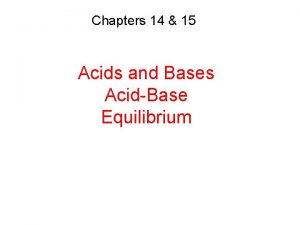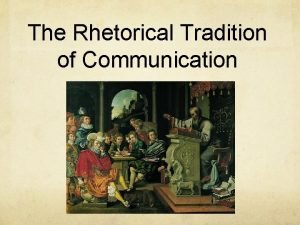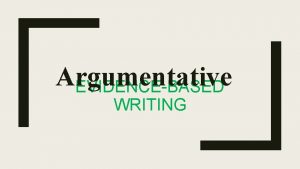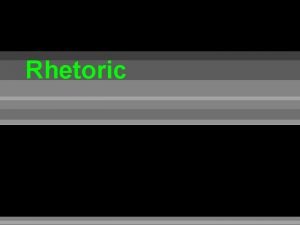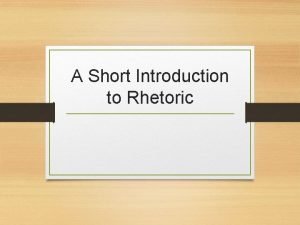The Rhetoric of an EDITORIAL HOOK Attentiongetter Strong








- Slides: 8

The Rhetoric of an EDITORIAL

HOOK (Attention-getter) ■ Strong statement creating intrigue and peeking curiosity Darwin was wrong. ■ Eye catching fact/statistic According to a recent poll, 87% of Americans believe there is a God. It makes you wonder how this widespread belief affects how we make laws in the U. S. ■ Provoking question When does a friendly flirtation at the office turn into sexual harassment? Many people ponder the murky line separating a bad idea from breaking the law.

■ Visualize hypothetical that emphasizes point Imagine waking up in the morning to find the electricity out, or a pipe burst or your car won’t start. As you look through the yellow pages for a technician, do you really care if that person has knowledge of matrices, oxidation numbers, and Kepler’s laws of planetary motion? ■ Anecdote/Relevant Story On a cold February Wednesday morning at 5 am, a bicyclist was shot by a man in an apparent road rage incident. Before he died, the wounded cyclist knocked on five doors crying and pleading for help, but no one answered.

Objective Explanation ■ Example 1: Historically, each state determines their own Good Samaritan Law and who to protect: the victim, the first responders, the bystander, and/or the Good Samaritan. In recent years, the Good Samaritan law provides less protection for the person that the law was first named after. ■ Example 2: Environmentalists and Industrialists have been clashing over climate change for a decade or more. Recently, this fight has escalated due to President Trumps plan to cut funding to the Environmental Agency and to roll back laws and regulations that have protected the environment. This section explains the larger picture behind the issue or controversy.

COUNTER-ARGUMENT: Part 1 ■ Concession : to admit there is an opposition/opposing viewpoint In the field of psychology, some experts say that it is a natural to experience debilitating fear when witnessing a violent event and this is why people stand by and watch. Additionally, others would argue that the residents who did not open their doors to help the wounded cyclist are absolved because good Samaritans have been sued for causing more harm than good.

COUNTER-ARGUMENT: ■ Refutation Part 2 : to refute, rebut, counter, disprove the opposing view Green = What you have to say to the opposition about what they “believe” or “say”. Explain why their thinking is wrong. So why is that some people are willing to come to the rescue of others, even strangers, and others are not? This knee-jerk sense of responsibility happens daily for police officers, fire fighters, and good Samaritans. The problem might lie less with our society’s lack of virtue and more with our lack of laws to legally protect good Samaritans. The current law in the state of Michigan only protects the bystander who does not help and emergency responders; consequently, the good Samaritan Law needs to be expanded to protect untrained responders so that more victims can be saved from a senseless death. Red = thesis statement

ANALOGY Drawing an acceptable similarity that strengthens your position. This add logic to your argument. ■ As a member of the human race, refusing to help someone in dire need is no different than a life guard unwilling to jump into the deep end of the pool to save a drowning person. It is part of our job description as human beings to help one another. ■ Additional example: Exposing children to secondhand smoke is like putting arsenic, formaldehyde, carbon monoxide (400 some toxins) in your child’s Cheerios and milk each morning. ■ The government misspending our tax dollars is no different than them burning our money ■ Withholding a college education from a low-income kid is like withholding the right to breath.

Solution, CALL TO ACTION, & RHETORICAL ? Green = Solution 1 Red= Solution 2 + Call to Action (use pronouns like us, we, our). Target your audience to be involved in the solution. So what can we do to solve this dilemma? We can start by changing Michigan’s laws to protect people who are being heroic. We can lead by example and be role models for our children by doing the right thing even when the going gets tough or we worry about the consequences. Then, and only then, will we be able to live with ourselves. So the next time an opportunity comes knocking to help a person in need and you consider not answering the call, ask yourself this question: If not me, then Bluewho? = Rhetorical Question *Word ? so the audience will answer it in favor of your opinion. You are trying to make a point!






